The holidays mean persimmons
Jeanne discusses the biology behind the strange winter beauty of
persimmon trees and demystifies why eating one before its time is an
unpleasant experience.
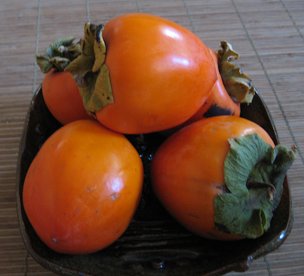
Hachiya persimmons, ripening
The
holiday seasons of my adult life increasingly include
persimmons. The ‘hachiya’ persimmons on my mother-in-law’s tree in
California ripen
around Christmas, beginning a conversation about what to do with them,
and when they start showing up in the grocery store in late fall, I’m
invariably drawn to the plump orange fruits with their handsome green
calyxes. I’ve now learned that persimmons, especially dried, are
an important part of many new year celebrations throughout Asia, where
there are thousands of persimmon varieties, but I only became
acquainted with them when I moved from Denver to go to college in the
Bay Area, where some of the Asian varieties are grown. The bright
orange plum-to-apple-sized persimmon fruits stay on the tree until well
after the leaves drop in the autumn. I paid little attention to
the persimmon trees on campus—tall specimens of the ‘Hachiya’ variety
of Asian Diospyros kaki—until the leaves fell to reveal the scraggly
branches laden with the orange orbs.
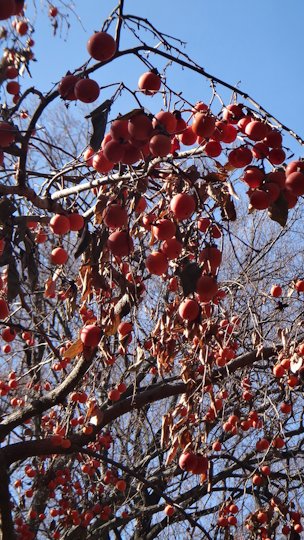
Japanese persimmon with fruit, National Arboretum
The
sight startled and fascinated me, and I still find it exciting but a
little unsettling. The trees in winter are certainly beautiful and
somewhat seasonally festive, but definitely foreign to me. Part
of their enigma for me might arise from the mystery of why a tree would
leave its fruit on the tree past leaf drop. This doesn’t seem to
be particularly well researched. It’s not necessarily a bad idea
if the cold fruits can still mature their seed, and the strategy could
be a great way to avoid some warm-season pests and pathogens, but I
haven’t found any data supporting any particular hypothesis on the
subject, and it bugs me.
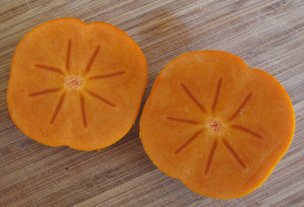
Cut fuyu persimmon, revealing empty carpels
Another
aspect of persimmon life history that intrigues me is their facultative
parthenocarpy—part-time seedlessness. Persimmons may occasionally
set seeds if the wind or an insect pollinates their flowers, and some
varieties produce sweeter, more flavorful fruit if the flowers were
pollinated, but many don’t require pollination in order to make
fruit. You’ll see this if you cut a commercial persimmon in half
cross-wise. You’ll see a star pattern of empty carpels where the
seeds would have grown. Many plants produce some seedless
fruits. In wild parsnip, the strategy has been shown to be an
effective strategy to prevent seed loss to herbivores, which prefer the
seedless fruits (Zangerl et al. 1991). Other researchers
hypothesize that parthenocarpy might help keep fruit dispersing animals
fed and in the region even if pollination fails in any given
year. Whether both or either of these functions of parthenocarpy
explain its persistence in persimmon is undemonstrated.

Wild persimmon seeds
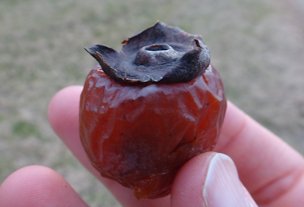
Ripe, post-frost wild persimmon fruit
My
illustrious blog co-author Katherine has fond memories of harvesting
the sweet wild persimmons in Indiana and related to me an interesting
story about persimmon folklore: “There is an old tale about
persimmon seeds foretelling the winter weather. If you cut the
seeds lengthwise and see a fork, there will be much snow. A knife
points to cold and a spoon points to mild weather. The utensils
are just the embryo, and the shape depends on your plane of
section. It clearly doesn’t work, but the legend persists.”
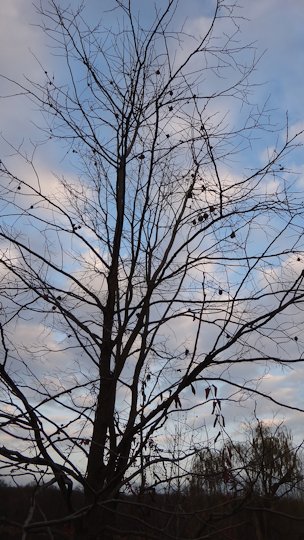
Wild persimmon tree with fruit
When
I got my hands on those first hachiyas, the timely advice of a friend
spared me the unpleasant experience of learning the hard way that most
persimmon varieties are inedibly astringent before they are either
completely ripe or dried. We had to set them out in the
windowsill until they were quite ripe. Perfectly ripe hachiyas
become translucent and jelly-like, and their flesh can be gently sliced
and dried or easily spooned out of the skin and eaten as is, whipped
with lemon juice in the blender for a refreshing, thick fruit mousse,
or incorporated into puddings, sorbets, or soups. Harold McGee
suggests making a two-layered persimmon pudding, one layer made with
baking soda and the other with baking powder. The former produces
an alkaline batter that turns the cooked pudding a rich dark brown via
browning chemical reactions and mellows the fruit flavor, whereas the
former preserves the honey-sweet but mild, pumpkin-like persimmon
flavor and produces a pale golden pudding.

Fuyu persimmons
Other
persimmon varieties, including fuyu or jiro, are non-astringent and can
be safely consumed when crisp but are more delicious when allowed to
soften and sweeten a bit, although they will never become as jelly-like
as the astringent varieties. The non-astringent varieties can be
eaten like an apple or peeled and sliced into salads or fresh chutneys
or salsas. Slicing fuyus into salads is our favorite way to
incorporate persimmons into our fall and winter menus.
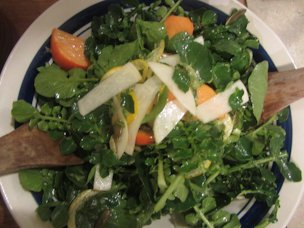
Fuyu slices in salad with watercress and shaved white turnip
Most
of the both astringent and non-astringent persimmon varieties grown in
the United States are cultivars developed in China and Japan of a
single species native to northern China with peach-sized fruit,
Diospyros kaki, which itself is just one of the 450-500 species in the
large genus Diospyros, in the family Ebenaceae (asterid order
Ericales—please see our food tree for phylogenetic context). The
family Ebenaceae gets its name from the other economically important
product of the genus Diospyros: ebony, the extraordinarily dark
and dense wood. Only a few species have the dark or streaked
heartwood harvested for ebony or calamander wood, respectively, and
those tend not to have particularly desirable fruit. All species
in the genus, however, have especially hard wood and make excellent
timber.
The high fruit tannin content is to blame for the
astringency. Tannins deter herbivores from eating the fruit until
the seeds, if they exist, are mature. Tannins are a large
chemical group of phenolic compounds that function by binding
protein. They cause the uncomfortable dry-mouth, furry-tongue
feeling that comes with biting an unripe persimmon (or unripe banana or
extraordinarily tannic wine or black tea) by binding the proteins in
your saliva to the proteins in your tongue. Large specialized
cells throughout the fruit store the tannins. Harold McGee
suggests an activity you can do the kitchen yourself to see these
tannin storage cells: place a pinch of baking soda on a small
amount of ripe persimmon pulp. In a few hours thousands of little
black rods will appear on the surface of the pulp, where the baking
soda oxidized the tannin masses and caused them to absorb enough light
to be visible. As the fruit ripens, acetaldehyde produced during
ripening causes the tannins to bind to each other, consolidating them
into unreactive masses inside their storage cells, removing the
astringency. The non-astringent varieties still have tannins, but
the tannin cells are much smaller and have less tannin. This
condition is caused by a recessive genetic mutation that interrupts
tannin cell development early (Kanzaki et al. 2001)
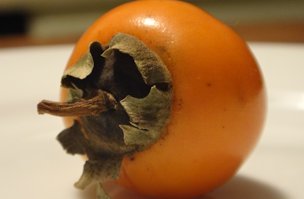
Japanese persimmon, still very much astringent
Freezing,
drying, mechanically whipping the fruit in a blender, and depriving the
fruits of oxygen in a bag in a warm place for a few days are other
mechanisms for modifying fruit cell metabolism and/or breaking the cell
walls, so that the tannins leak out and bind to other proteins in the
fruit and thereby become inactive. Katherine remembers that the
wild persimmons in Indiana were traditionally harvested after the first
frost, to ensure loss of astringency through both ripening and
freezing. This tannin leaking-and-binding also thickens the fruit
pulp and can turn ripe persimmon fruit into a lovely fruit mousse or
sorbet, no eggs or cream or gelatin needed. But this thickening
can also hurt you. If you eat too much ripe persimmon on an empty
stomach, the thickening will happen so quickly and vigorously inside
your stomach that it can bind the persimmon tissue into an indigestible
mass—a bezoar—that cannot pass into your intestine and can cause
digestive havoc and will require surgery. Seriously. So,
persimmons in moderation and with other food, please. And happy
holidays!
References
Kanzaki,
S, K. Yonemori, and A. Sugiura. 2001. Identification of molecular
markers linked to the trait of natural astringency loss of Japanese
persimmon (Diospyros kaki) fruit. J. Amer. Soc. Hort. Sci. 126: 51-55.
McGee, H. 1990. The Curious Cook. Collier Books, New York.
Zangerl,
AR, JK Nitao, and MR Berenbaum. 1991. Parthenocarpic fruits in wild
parsnip: decoy defence against a specialist herbivore. Evolutionary
Ecology 5: 136–45.
Back to
PersimmonPage
|








